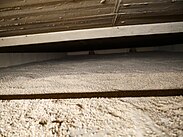Underground car park at the train station
The former civil defense multi-purpose underground car park Am Bahnhof in Unna was built for the population of the city of Unna on the occasion of the Cold War . Planning began in the 1970s and commissioning took place a decade later on May 20, 1983. The bunker should have protected up to 3,000 people in the event of a nuclear strike by the time it was decommissioned around the turn of the millennium .
Access
The bunker can now be reached via the normal underground car park entrance as well as via the regular visitor entrances to the car park. In the past it would have been accessible via three additional entrances, which still exist today.
The protection system is located on parking levels 3, 4 and 5. Four radiation protection barriers weighing around 8 tons separate the protection area from the normal underground car park. The gates can be locked by hand with an associated crank. A normal person would need about three quarters of an hour to lock a door. For pedestrians, the decks can be reached via two stairwells, which on decks 3, 4 and 5 have a fire protection door as well as an air protection door or pressure door. From the facility you can look through a lock window made of lead glass into the lock chamber, which separates the civil defense system from the unprotected outside world.
If all doors and gates of the air protection system are closed, the bunker is hermetically sealed .
Degree of protection
Since the 1960s and 1970s, multi-purpose civil defense systems have no longer been designed to withstand direct hits, but merely offer protection from radioactive radiation , chemical and biological weapons , rubble, pressure waves, and fire and heat . The ceiling thickness of such systems is only about 0.40 meters.
Ventilation system
The three large cylinders next to the Hotel Katharinenhof are part of the ventilation system for the underground car park. The extension of the hotel was only possible because the nuclear shelter was taken out of service. Before that, the extension would have been too close to the cylinders and in the event of a bomb attack, rubble from the hotel extension could have destroyed the ventilation system. The air is filtered through a sand filter and an activated carbon filter . The exhaust air was led out of the bunker via pressure relief valves, thus ensuring the necessary excess pressure in the bunker system. The unfiltered ventilation system, which was active during normal operation of the underground car park or is still active today, could be locked by quick-closing flaps in the event of protection.
Power supply
The normal power supply for the bunker would have been provided by the Unna municipal utility . In the event of a power failure, a diesel engine would have supplied the bunker with power as an emergency generator , so that ventilation, lighting, etc. would have been guaranteed. The fuel was stored in a 12,000 liter oil tank inside the facility. The engine's exhaust gases were emitted through a pipe that is still visible today. Even today, the emergency generator is still used for the underground car park.
Life in the bunker
In an emergency, the bunker would have protected up to 3,000 people. 1000 people should have been accommodated on each of the three decks. The food supplies were designed for about 14 days. There were no sanitary facilities, instead plastic curtains would have been hung in the ceiling on each deck and dry toilets were placed in these makeshift cubicles (18 per deck). 5000 bags of faeces were stored in the storage rooms because the toilets did not have a drain.
closure
The plant was taken out of service around the turn of the millennium. Peer Steinbrück personally released the city from the existing earmarking (see costs and construction ).
Cost and construction
The cost of construction of the bunker were about 20 million German marks . The construction was subsidized with 5,000,000 D-Marks from the Federal Republic , but on the condition that the plant remains in operation for 30 years ( earmarked ). Furthermore, 25,000 D-Marks were paid to the city every year in order to maintain the plant.
The then city director Klaus Dunker played a key role in the construction.
criticism
The GAL (Green Alternative List) criticized the construction of the bunker. For the opening of the bunker, they issued a satirical invitation poster.
Here is an excerpt which has become a well-known proverb:
"As part of the festive opening of the 20 million underground car park on Friday, May 20th at 11 am, City Director Bunker-Dunker will open the 5 million Dunker-Bunker."
Web links
- https://www.facebook.com/events/hansetourist-unna/kalter-krieg-in-unna-f%C3%BChrung-durch-den-atombunker/517543605740741/
- https://www.geschichtsspuren.de/artikel/bunker-luftschutz-zivilschutz/194-zivilschutzanlagen-ueberblick.html
- https://www.geschichtsspuren.de/component/fabrik/details/6/1802.html
- https://www.geschichtsspuren.de/images/stories/zsadb/1983-BunkerDunker-or-Neu.jpg
More pictures
Individual evidence
- ↑ As part of the festive opening of the 20 million underground car park on Friday, May 20th at 11 a.m., City Director Bunker-Dunker opens the 5 million Dunker-Bunker.








